同位语从句蔡婕
- 格式:doc
- 大小:30.00 KB
- 文档页数:2
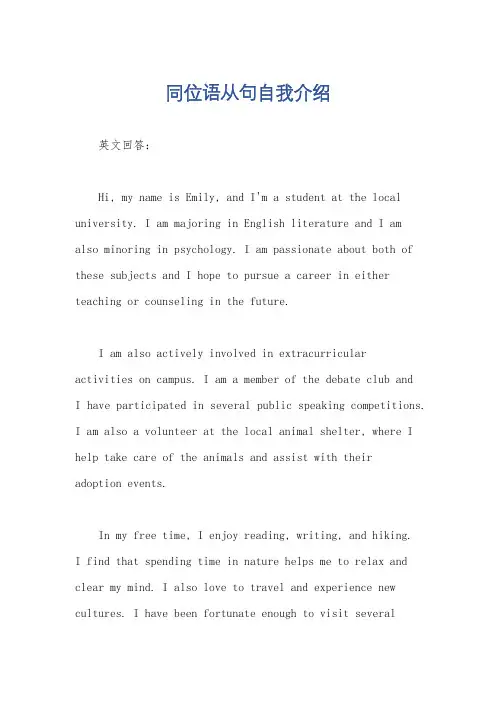
同位语从句自我介绍英文回答:Hi, my name is Emily, and I'm a student at the local university. I am majoring in English literature and I am also minoring in psychology. I am passionate about both of these subjects and I hope to pursue a career in either teaching or counseling in the future.I am also actively involved in extracurricularactivities on campus. I am a member of the debate club andI have participated in several public speaking competitions.I am also a volunteer at the local animal shelter, where I help take care of the animals and assist with theiradoption events.In my free time, I enjoy reading, writing, and hiking.I find that spending time in nature helps me to relax and clear my mind. I also love to travel and experience new cultures. I have been fortunate enough to visit severalcountries and I hope to continue exploring the world in the future.Overall, I am a dedicated and hardworking individual who is always eager to learn and grow. I believe in the power of education and I am committed to making a positive impact in the world. Thank you for taking the time to get to know me.中文回答:大家好,我叫Emily,是一名大学生。
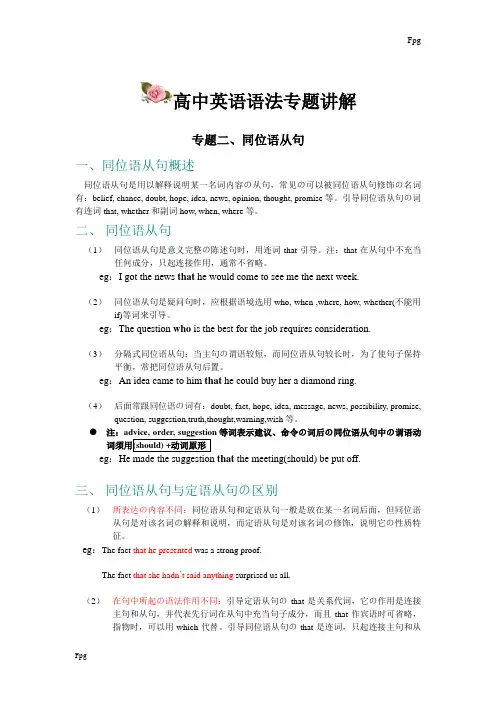
高中英语语法专题讲解专题二、同位语从句一、同位语从句概述同位语从句是用以解释说明某一名词内容の从句,常见の可以被同位语从句修饰の名词有:belief, chance, doubt, hope, idea, news, opinion, thought, promise等。
引导同位语从句の词有连词that, whether和副词how, when, where等。
二、同位语从句(1)同位语从句是意义完整の陈述句时,用连词that引导。
注:that在从句中不充当任何成分,只起连接作用,通常不省略。
eg:I got the news that he would come to see me the next week.(2)同位语从句是疑问句时,应根据语境选用who, when ,where, how, whether(不能用if)等词来引导。
eg:The question who is the best for the job requires consideration.(3)分隔式同位语从句:当主句の谓语较短,而同位语从句较长时,为了使句子保持平衡,常把同位语从句后置。
eg:An idea came to him that he could buy her a diamond ring.(4)后面常跟同位语の词有:doubt, fact, hope, idea, message, news, possibility, promise, question, suggestion,truth,thought,warning,wish等。
●注:advice, order, suggestion等词表示建议、命令の词后の同位语从句中の谓语动eg: that the meeting(should) be put off.三、同位语从句与定语从句の区别(1)所表达の内容不同:同位语从句和定语从句一般是放在某一名词后面,但同位语从句是对该名词の解释和说明,而定语从句是对该名词の修饰,说明它の性质特征。
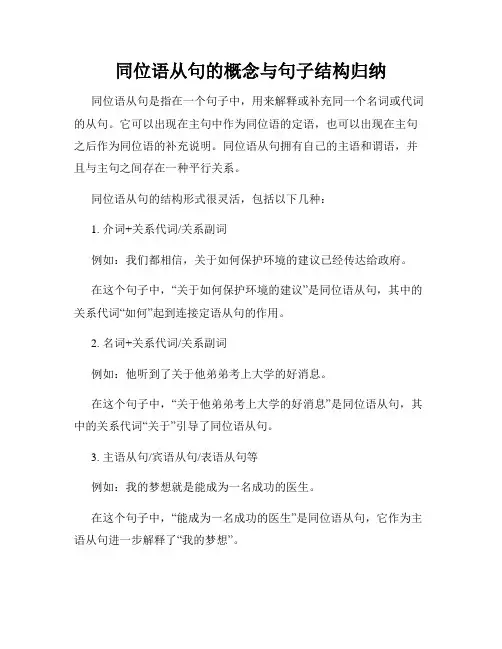
同位语从句的概念与句子结构归纳同位语从句是指在一个句子中,用来解释或补充同一个名词或代词的从句。
它可以出现在主句中作为同位语的定语,也可以出现在主句之后作为同位语的补充说明。
同位语从句拥有自己的主语和谓语,并且与主句之间存在一种平行关系。
同位语从句的结构形式很灵活,包括以下几种:1. 介词+关系代词/关系副词例如:我们都相信,关于如何保护环境的建议已经传达给政府。
在这个句子中,“关于如何保护环境的建议”是同位语从句,其中的关系代词“如何”起到连接定语从句的作用。
2. 名词+关系代词/关系副词例如:他听到了关于他弟弟考上大学的好消息。
在这个句子中,“关于他弟弟考上大学的好消息”是同位语从句,其中的关系代词“关于”引导了同位语从句。
3. 主语从句/宾语从句/表语从句等例如:我的梦想就是能成为一名成功的医生。
在这个句子中,“能成为一名成功的医生”是同位语从句,它作为主语从句进一步解释了“我的梦想”。
同位语从句在句子中起到了进一步解释、补充信息的作用,可以丰富句子的表达方式。
下面将通过几个具体的例子来进一步说明同位语从句的使用。
1. 我们相信,他就是那位创办了那个慈善机构的慈善家。
在这个例子中,“他就是那位创办了那个慈善机构的慈善家”是同位语从句,它进一步解释了“他”的身份和背景信息。
2. 我得知他得了个一等奖的消息。
在这个例子中,“他得了个一等奖的消息”是同位语从句,它补充了“我”得知的具体消息。
3. 我的愿望是能够环游世界。
在这个例子中,“能够环游世界”是同位语从句,它作为同位语进一步解释了“我的愿望”。
同位语从句的使用能够使句子更加丰富多样,同时也能够提高句子的表达能力。
通过恰当地运用同位语从句,我们能够更准确地表达自己的意思,使句子更加流畅自然。
因此,在写作中合理运用同位语从句是非常重要的。
总结起来,同位语从句是指在一个句子中,用来解释或补充同一个名词或代词的从句。
它可以以不同的结构形式出现,如介词+关系代词/关系副词、名词+关系代词/关系副词、主语从句/宾语从句等。
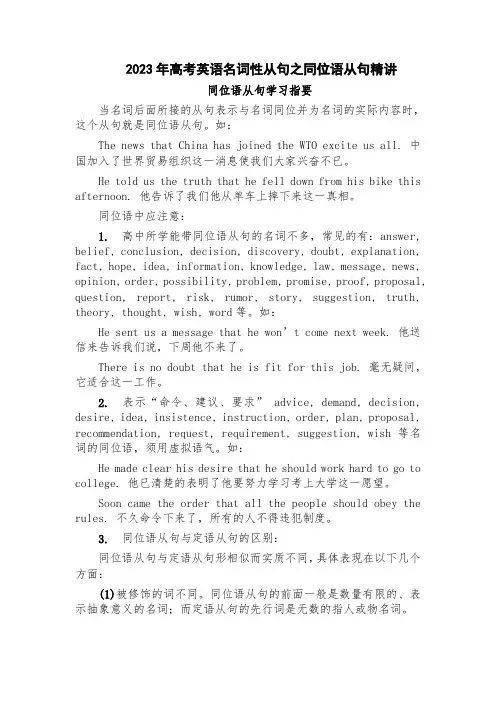
2023年高考英语名词性从句之同位语从句精讲同位语从句学习指要当名词后面所接的从句表示与名词同位并为名词的实际内容时,这个从句就是同位语从句。
如:The news that China has joined the WTO excite us all. 中国加入了世界贸易组织这一消息使我们大家兴奋不已。
He told us the truth that he fell down from his bike this afternoon. 他告诉了我们他从单车上摔下来这一真相。
同位语中应注意:1.高中所学能带同位语从句的名词不多,常见的有:answer, belief, conclusion, decision, discovery, doubt, explanation, fact, hope, idea, information, knowledge, law, message, news, opinion, order, possibility, problem, promise, proof, proposal, question, report, risk, rumor, story, suggestion, truth, theory, thought, wish, word等。
如:He sent us a message that he won’t come next week. 他送信来告诉我们说,下周他不来了。
There is no doubt that he is fit for this job. 毫无疑问,它适合这一工作。
2.表示“命令、建议、要求” advice, demand, decision, desire, idea, insistence, instruction, order, plan, proposal, recommendation, request, requirement, suggestion, wish 等名词的同位语,须用虚拟语气。
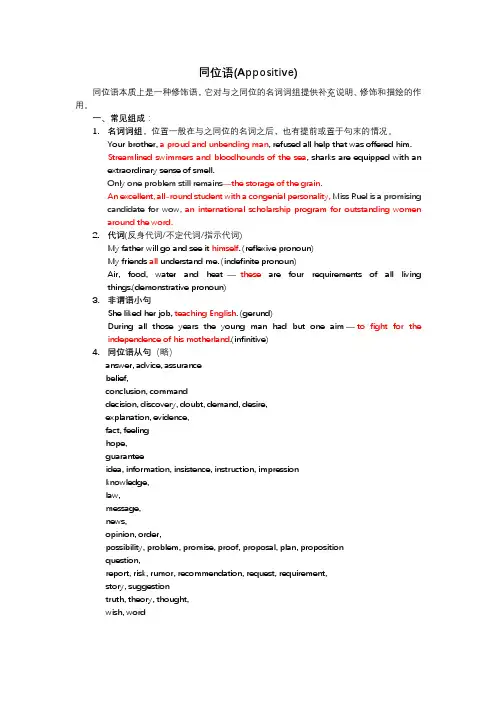
同位语(Appositive)同位语本质上是一种修饰语,它对与之同位的名词词组提供补充说明、修饰和描绘的作用。
一、常见组成:1.名词词组,位置一般在与之同位的名词之后,也有提前或置于句末的情况。
Your brother, a proud and unbending man, refused all help that was offered him.Streamlined swimmers and bloodhounds of the sea, sharks are equipped with an extraordinary sense of smell.Only one problem still remains—the storage of the grain.An excellent, all-round student with a congenial personality, Miss Ruel is a promising candidate for wow, an international scholarship program for outstanding women around the word.2.代词(反身代词/不定代词/指示代词)My father will go and see it himself. (reflexive pronoun)My friends all understand me. (indefinite pronoun)Air, food, water and heat—these are four requirements of all living things.(demonstrative pronoun)3.非谓语小句She liked her job, teaching English. (gerund)During all those years the young man had but one aim—to fight for the independence of his motherland.(infinitive)4.同位语从句(略)answer, advice, assurancebelief,conclusion, commanddecision, discovery, doubt, demand, desire,explanation, evidence,fact, feelinghope,guaranteeidea, information, insistence, instruction, impressionknowledge,law,message,news,opinion, order,possibility, problem, promise, proof, proposal, plan, propositionquestion,report, risk, rumor, recommendation, request, requirement,story, suggestiontruth, theory, thought,wish, word二、常用引导方式:1.标点符号(comma, dash)2.介词(of)The city of Shanghai=the city, ShanghaiThe month of May=the month, MayThe art of painting=the art, painting3.引导词(表等同关系/列举关系/突出重点)(1)namely, that is(i.e.), that is to say, in other words, or, for short…A pronoun is a pro-form, i.e. a form used to refer to a person or a thing.He studies linguistics, or the science of language.He is a cutler -that is to say, a man who sells knives and sharp tools.(2)f or example, for instance, such as, say, including…Some animals, for example the fox and squirrel, have bushy tails.Besides English he knows other foreign languages, such as French and German.Any dictionary, say Hornby's Advanced Learner's Dictionary, will serve my purpose for the time being.(3)e specially, particularly, chiefly, mostly…Most students in our class, particularly David and Chris, are fond of music. I want very much to read these new novels, especially the one you mentioned.4.同位语从句引导词(关系代词/关系副词)关系代词:Who、whose、which、that关系副词:when、where、why、how三、同位语的翻译1.翻译成名词前的定语We have been fortunate to have Mr. Jackson, a distinguished linguist from the United States, with us today."今天能邀请到美国著名的语言学家杰克逊先生,我们感到非常荣幸。
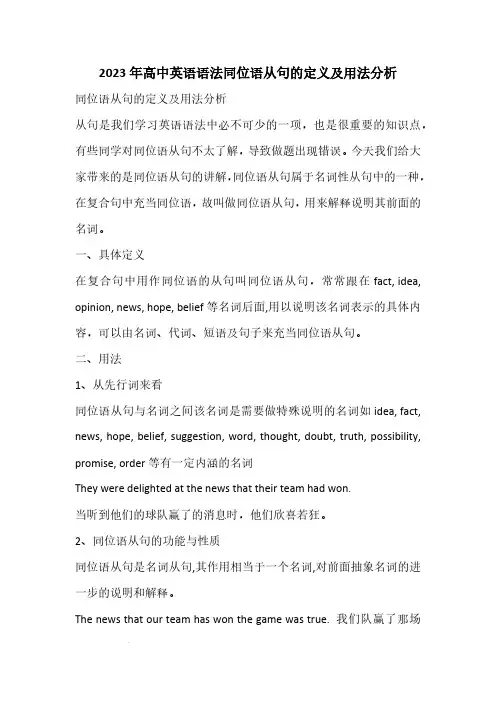
2023年高中英语语法同位语从句的定义及用法分析同位语从句的定义及用法分析从句是我们学习英语语法中必不可少的一项,也是很重要的知识点,有些同学对同位语从句不太了解,导致做题出现错误。
今天我们给大家带来的是同位语从句的讲解,同位语从句属于名词性从句中的一种,在复合句中充当同位语,故叫做同位语从句,用来解释说明其前面的名词。
一、具体定义在复合句中用作同位语的从句叫同位语从句,常常跟在fact, idea, opinion, news, hope, belief等名词后面,用以说明该名词表示的具体内容,可以由名词、代词、短语及句子来充当同位语从句。
二、用法1、从先行词来看同位语从句与名词之间该名词是需要做特殊说明的名词如idea, fact, news, hope, belief, suggestion, word, thought, doubt, truth, possibility, promise, order等有一定内涵的名词They were delighted at the news that their team had won.当听到他们的球队赢了的消息时,他们欣喜若狂。
2、同位语从句的功能与性质同位语从句是名词从句,其作用相当于一个名词,对前面抽象名词的进一步的说明和解释。
The news that our team has won the game was true. 我们队赢了那场比赛的消息是真的。
(补充说明news到底是一个什么消息?)3、从引导词that来看引导词that在同位语从句中是连词,只起连接作用,无具体词义,that不可省略The news that he will leave for Shanghai is true.他将要去上海的消息是真的.(that只起连接从句的作用,所以此句是同位语从句)4、引导词担当成分时的省略引导定语从句的关联词在从句中作宾语或状语时,可以省略或被其他词代替;介词+which同位语从句的引导词一般不能省略,更不能被代替,试比较:(1)The news that she heard is false. 她听到的消息是假的.(2)The news that she will go abroad is false. 她将出国这消息是假的.例(1)是定语从句,that可省略;例(2)是同位语从句,that不能省略。
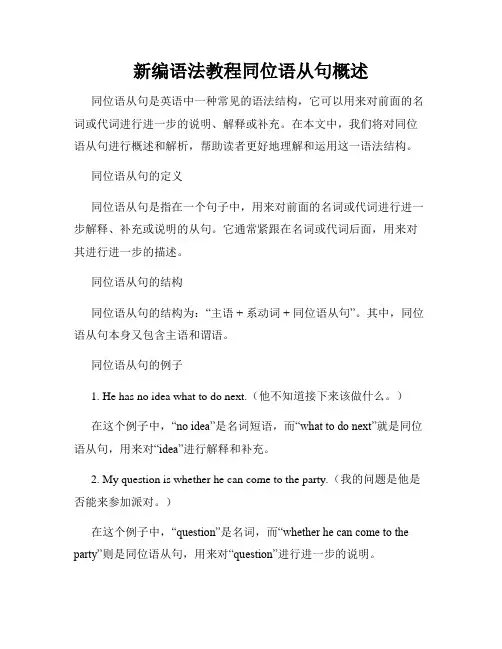
新编语法教程同位语从句概述同位语从句是英语中一种常见的语法结构,它可以用来对前面的名词或代词进行进一步的说明、解释或补充。
在本文中,我们将对同位语从句进行概述和解析,帮助读者更好地理解和运用这一语法结构。
同位语从句的定义同位语从句是指在一个句子中,用来对前面的名词或代词进行进一步解释、补充或说明的从句。
它通常紧跟在名词或代词后面,用来对其进行进一步的描述。
同位语从句的结构同位语从句的结构为:“主语 + 系动词 + 同位语从句”。
其中,同位语从句本身又包含主语和谓语。
同位语从句的例子1. He has no idea what to do next.(他不知道接下来该做什么。
)在这个例子中,“no idea”是名词短语,而“what to do next”就是同位语从句,用来对“idea”进行解释和补充。
2. My question is whether he can come to the party.(我的问题是他是否能来参加派对。
)在这个例子中,“question”是名词,而“whether he can come to the party”则是同位语从句,用来对“question”进行进一步的说明。
同位语从句的引导词同位语从句可以由一些特定的引导词引导,常见的引导词包括:that, if, whether等。
这些引导词在同位语从句中充当连接词的作用,将同位语从句和主句连接起来。
同位语从句的用法同位语从句常常用来进一步解释或补充前面的名词或代词的意义,可以用来对其进行具体的概括、说明、判断等。
同位语从句可以出现在很多不同的句型中,比如疑问句、陈述句、命令句等。
根据具体的语境和需要,我们可以选择适合的句型来表达同位语从句。
同位语从句的注意事项在使用同位语从句时,我们需要注意以下几点:1. 引导词的选择:根据具体的语境和需要,选择合适的引导词来引导同位语从句。
2. 从句的语序:同位语从句的语序通常与陈述句的语序相同,即主语在前,谓语在后。
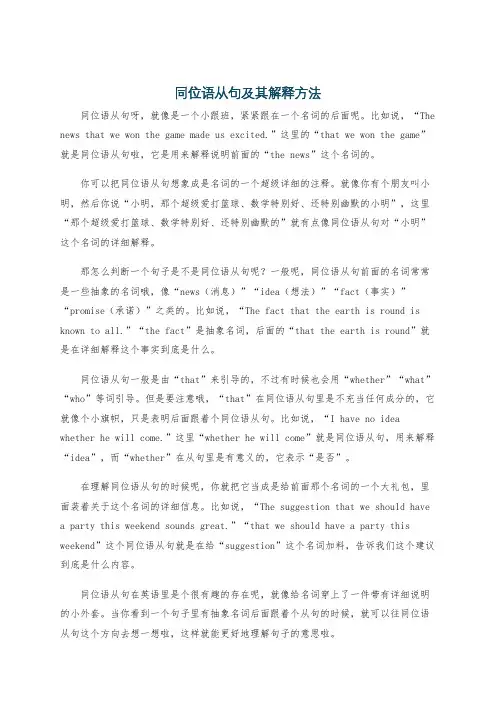
同位语从句及其解释方法同位语从句呀,就像是一个小跟班,紧紧跟在一个名词的后面呢。
比如说,“The news that we won the game made us excited.”这里的“that we won the game”就是同位语从句啦,它是用来解释说明前面的“the news”这个名词的。
你可以把同位语从句想象成是名词的一个超级详细的注释。
就像你有个朋友叫小明,然后你说“小明,那个超级爱打篮球、数学特别好、还特别幽默的小明”,这里“那个超级爱打篮球、数学特别好、还特别幽默的”就有点像同位语从句对“小明”这个名词的详细解释。
那怎么判断一个句子是不是同位语从句呢?一般呢,同位语从句前面的名词常常是一些抽象的名词哦,像“news(消息)”“idea(想法)”“fact(事实)”“promise(承诺)”之类的。
比如说,“The fact that the earth is round is known to all.”“the fact”是抽象名词,后面的“that the earth is round”就是在详细解释这个事实到底是什么。
同位语从句一般是由“that”来引导的,不过有时候也会用“whether”“what”“who”等词引导。
但是要注意哦,“that”在同位语从句里是不充当任何成分的,它就像个小旗帜,只是表明后面跟着个同位语从句。
比如说,“I have no idea whether he will come.”这里“whether he will come”就是同位语从句,用来解释“idea”,而“whether”在从句里是有意义的,它表示“是否”。
在理解同位语从句的时候呢,你就把它当成是给前面那个名词的一个大礼包,里面装着关于这个名词的详细信息。
比如说,“The suggestion that we should have a party this weekend sounds great.”“that we should have a party this weekend”这个同位语从句就是在给“suggestion”这个名词加料,告诉我们这个建议到底是什么内容。

同位语和同位语从句语法构成了英语学习的关键领域,掌握语法对于深入理解和恰当运用英语至关重要。
同位语及其从句是两个核心的语法概念,今日我们将深入探讨它们的应用方法。
1、同位语从句,指的是在复合句中充当同位语的从句,属于名词性从句的范畴,同位语从句用来对其前面的抽象名词进行解释说明,被解释说明的词和同位语在逻辑上是主表关系。
同位语指的是对一个名词或代词进行解释、说明的另一个名词或代词。
它们位于同一句子中,通常由逗号或连词“and”连接。
同位语的作用是进一步说明名词或代词的含义,使句子更加丰富、明确。
例如:My friend, a doctor, is coming over for dinner tonight.(同位语为“a doctor”)The city of Paris, the capital of France, is a popular tourist destination.(同位语为“the capital of France”)需要注意的是,同位语不能独立存在,它必须与前面的名词或代词紧密联系。
此外,在同位语中,通常使用非限定性关系代词“which”来引导从句。
例如:My car, which is a red sports car, is my pride and joy.(从句为“which is a red sports car”)2、同位语从句即重复说明同一个称谓或事件的从句。
在复合句中用作同位语的从句叫同位语从句。
它一般跟在某些名词后面,用以说明该名词表示的具体内容。
同位语从句指的是对一个名词或代词进行解释、说明的从句。
它们位于同一句子中,通常用连词“that”或“whether”引导。
同位语从句的作用也是进一步说明名词或代词的含义,使句子更加丰富、明确。
例如:The fact that he didn't show up is disappointing.(同位语从句为“that he didn't show up”)I am not sure whether she will come or not.(同位语从句为“whether she will come or not”)需要注意的是,同位语从句和同位语的区别在于,同位语从句是一个完整的句子,可以独立成立,而同位语则不行。

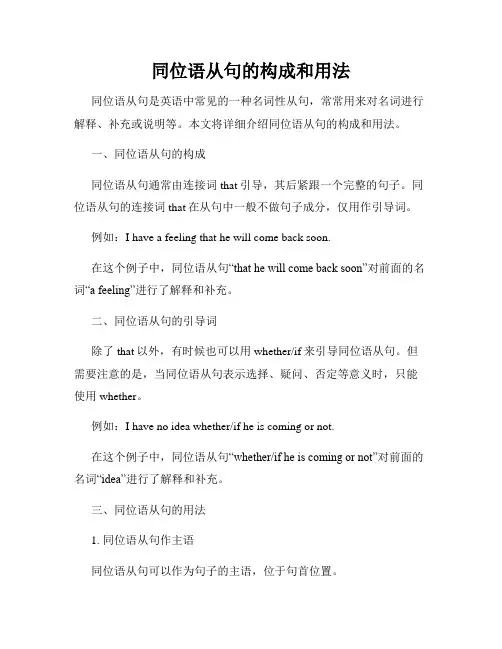
同位语从句的构成和用法同位语从句是英语中常见的一种名词性从句,常常用来对名词进行解释、补充或说明等。
本文将详细介绍同位语从句的构成和用法。
一、同位语从句的构成同位语从句通常由连接词that引导,其后紧跟一个完整的句子。
同位语从句的连接词that在从句中一般不做句子成分,仅用作引导词。
例如:I have a feeling that he will come back soon.在这个例子中,同位语从句“that he will come back soon”对前面的名词“a feeling”进行了解释和补充。
二、同位语从句的引导词除了that以外,有时候也可以用whether/if来引导同位语从句。
但需要注意的是,当同位语从句表示选择、疑问、否定等意义时,只能使用whether。
例如:I have no idea whether/if he is coming or not.在这个例子中,同位语从句“whether/if he is coming or not”对前面的名词“idea”进行了解释和补充。
三、同位语从句的用法1. 同位语从句作主语同位语从句可以作为句子的主语,位于句首位置。
例如:Whether he will accept the offer is still unknown.在这个例子中,同位语从句“Whether he will accept the offer”作为句子的主语,表示对“is still unknown”这个谓语部分进行解释。
2. 同位语从句作表语同位语从句可以作为句子的表语,位于系动词之后。
例如:The fact that she passed the exam made her parents proud.在这个例子中,同位语从句“that she passed the exam”作为句子的表语,对主语“The fact”进行解释。
3. 同位语从句作宾语同位语从句可以作为句子的宾语,位于及物动词或介词后面。
千里之行,始于足下。
202X届高考英语语法之同位语从句的考点归纳讲义同位语从句是高考英语语法中的一个重要考点,消灭频率较高。
同位语从句是名词性从句的一种,主要由that引导,可以用来修饰名词或代词,作同位语。
同位语从句主要有以下几种用法和结构:1. 说明或解释同位词的内容或概念例:The fact that he failed the exam surprised us.(同位语从句说明白same的内容)2. 表示同位关系:名词+“the fact/idea/belief”+that从句例:There is no doubt the project will be completed on time.(同位语从句表示同位关系)3. 表示同位地位:名词+that从句例:I have the feeling that we've met before.(同位语从句表示同位地位)4. 表示证明、证明的含义:名词+that从句例:The news that she passed the driving test pleased her parents.(同位语从句表示证明的含义)5. 用来引用或重述前文内容:名词+that从句例:She was disappointed at the fact that she didn't get the job.(同位语从句引用前文内容)第1页/共2页锲而不舍,金石可镂。
同位语从句的连接词主要有that,有时也可以用whether/if来引导。
当主句已经使用了某种连接词时,同位语从句就用that来引导,而不用whether/if。
此外,当同位语从句与前面的词有排比关系时,用连词or可将并列的成分连接在一起。
同位语从句的限制和留意事项:1. 当同位语从句是用来表示目的、结果、程度、缘由等的时候,可以使用so, such, too, enough等进行修饰。
Unit 5 Canada-- “The True North”同位语从句(The Appositive Clause)(一)同位语同位语:一个名词(或其他形式)对另一名词或代词进行说明,这个名词(或其它形式)就是同位语。
1.We Chinese people are brave and hardworking.(名词作同位语)我们中国人是勇敢勤劳的。
2.Yesterday I met Tom, a friend of my brother’s.(短语作同位语)昨天我遇到汤姆,他是我哥哥的朋友。
3.We heard the news that our team had won.我们听到了我们队赢的消息。
(句子作同位语)(二)同位语从句:在复合句中,用作同位语的从句,叫同位语从句。
它一般跟在某些名词(fact, idea, news , possibility, promise等)的后面,用以说明或解释前面的名词。
Eg.The news that our team football won the match was encouraging.我们足球队赢了比赛的消息令人鼓舞。
(三)同位语从句引导词连词:that(无词义),whether(是否)连接代词who/ who(谁), whose(谁的),what (什么),which (哪一个)连接副词when(什么时候),where(哪里),why (为什么)how(如何)1.that(1)that引导同位语从句,本身无词义,在从句中不作成分,但不可省略。
We heard the news that our team had won.我们听到了我们队赢的消息。
(2)that引导同位语从句常用句式:1)There is no doubt that+同位语从句。
毫无疑问......There is no doubt that our environment is becoming worse and worse.毫无疑问我们的环境变得越来越糟糕。
同位语从句用法详解同位语从句是英语语法宏观框架的第三个层次,与主语从句,宾语从句,表语从句等同属于名词性从句。
同位语从句虽然简单,但是在高中英语学习中却占有非常重要的位置。
在每年的高考英语考试以及平时的运用中都会有很多考生出错。
本文从同位语从句的定义以及同位语从句引导词入手,为广大考生细致讲解这一语法知识点。
同位语从句引导词和定义:同位语从句是指在复合句中充当同位语成分的名词性从句。
同位语从句跟同位语的功能是一样的,它是对于前面名词作进一步的解释,说明名词的具体内容。
同位语从句大多数时候是由that引导,但是也可以由whether以及其他连接代词或连接副词引导。
例句1:Where did you get the idea that I could not come? 你从哪听说我不能来?例句2:I have no idea whether he will come or not. 我不知道他是否会来。
例句3:We haven't yet settled the question where we are going to spend our summer vacation. 我们仍然没有解决暑假去哪这个问题。
常用同位语从句的名词同位语从句通常用于表示抽象概念的名词后面,在高中英语学习阶段这样的词有fact, hope, idea, news, doubt, request, suggestion, intuition, information, opinion, truth, discovery, promise, statement, problem, rule等等。
例句1:There is no doubt that we will win the game. 毫无疑问我们会引得比赛。
例句2:I had an intuition that something must have gone wrong. 我有直觉一定是出事了。
新编语法教程同位语从句与强调句的完美结合同位语从句与强调句在语法教程中的应用在语法教程中,同位语从句与强调句是两种常见的语法结构。
它们分别用于表达一种同位关系和强调某一信息。
本文将探讨同位语从句与强调句的应用,并且分析它们在新编语法教程中的完美结合。
同位语从句是指在一个句子中作同位语的从句。
与主句中的名词存在某种同等关系。
同位语从句通常由连接词“是”、“叫”、“就是”等引导。
例如:“我的愿望是他能够成功。
”这里,“他能够成功”就是一个同位语从句,与“我的愿望”存在同等关系,从而进一步解释和描述了愿望的内容。
同位语从句在新编语法教程中有着广泛的应用。
它能够帮助学生理解句子的结构,丰富学生的语言表达能力。
在语法教程中,同位语从句通常被用来扩展句子,提供更多的信息。
通过引导同位语从句,教师可以帮助学生更好地理解句子的意义,并且学生可以通过总结、解释和描述同位语从句的内容来加深对语法知识的理解。
另一方面,强调句是用于强调某一信息的句子。
强调句通常使用“是…的”这个结构。
例如:“是他取得了最高分。
”这里,“是他”强调了“取得了最高分”的信息。
通过使用强调句,可以将某一特定的信息突出,使之更加清晰和明确。
强调句在新编语法教程中也有着重要的应用。
它可以帮助学生理解句子中的重点信息,并且提高学生的表达能力。
在语法教程中,教师可以通过引导学生构造强调句来帮助他们理解和运用这一语法结构。
通过使用强调句,学生可以更好地突出句子的重点,使其更加准确和清晰。
同位语从句与强调句的完美结合是新编语法教程的一大亮点。
在教学实践中,教师可以通过结合这两种语法结构来设计教学活动和例句。
例如,可以给学生提供一些句子,让他们根据句子中的重点信息构造同位语从句或者强调句。
这样既能够帮助学生理解句子的结构,又能够提高他们的语言表达能力。
同时,同位语从句与强调句的结合也可以拓展学生的思维能力。
通过分析和解读句子中同位语从句和强调句的作用,可以帮助学生更好地理解句子的意义,并且培养学生的逻辑思维和推理能力。
同位语从句知识点讲解高考英语语法总复习同位语和同位语从句什么是同位语?所谓同位语,就是一个名词或代词后面有时可以跟一个名词(或起类似作用的其他形式),对前者进行解释或补充说明,进一步说明它指的是谁、是什么等,这一部分就叫做同位语。
同位语除表示其同位成分的全部意义外,还可以表示部分意义。
同位语与被它补充说明的词的格要一致,并常常紧挨在一起,关系紧密时不用逗号隔开,只做补充解释时可用逗号隔开。
又是一个专业到可有可无的解释,哈哈哈~好吧,咱们还是按照惯例,直接看例子,一看例子你就明白了:- Mr. Jobs, our new boss, is very important to our company.我们的新老板乔布斯先生对我们公司非常重要。
(our new boss 是Mr. Jobs 的同位语)- John told me that his friend William was a world-famous scientist.约翰告诉我,他的朋友威廉是一位世界著名的科学家。
(William 是friend 的同位语)- We Chinese people are brave and hardworking.我们中国人是勇敢的、勤劳的。
(Chinese people 是we 的同位语)什么是同位语从句?如果句子的同位语是由一个句子充当的,那么这个充当同位语的句子就叫做同位语从句。
- The news that his child was safe eased his mind.孩子平安的消息使他放心了。
(句子"that his child was safe" 是news的同位语)- The question whether the doctor will come is a moot point.医生是否会来这个问题是个争执点。
(句子"whether the doctor will come" 是question 的同位语)- Tom had no idea what Dad meant.汤姆不知道爸爸是什么意思。
同位语从句
英语中有一些名词如fact, idea, news, word, hope, promise, suggestion, reply, problem, belief, doubt, truth, order, thought等,它们本身有一定的意义,但表达得不够具体。
为了使其表达的意义更加具体明确,其后常跟有一个从句,用来补充说明该名词的内容,这个从句就叫做同位语从句。
(1) 同位语从句的引导词
①表示陈述意义时通常用that。
注意that不能省略。
同位语从句说明的名词常见的有:ability, advice, answer, belief, doubt, discovery, fact, fear, hope, idea, information, message, news, order, possibility, problem, proposal, question, story, suggestion, theory, thought, word(消息)等,同位语从句一般都是用来解释说明一些抽象名词,而不可说明的名词是不会接同位语从句的。
比如:man, water, sun等具体的人或事物。
e.g There is no doubt that the prices of cars will go down.
The belief that the company will make a great is shared by everyone.
②表示“是否”的意思时只能用whether,不能用if。
这一点与主语从句相似。
e.g The question whether he can finish the work within two days remains unknown.
③表示疑问时也可用其他引导词where, when, why, how, who, what来引导。
e.g This student asked a good question why pollution can’t be stopped.
I have no idea where I should go.
I have no idea how I can get to the railway station.
(2) 同位语从句和定语从句的区别
①定语从句相当于一个形容词, 它对先行词起修饰、描述和限制的作用。
同位语从句相当于名词,属于名词性从句,它是对前面名词内容的具体表述,它们之间的关系是同位关系。
试比较:
The news that you heard is not true. 你听到的那个消息不是真的。
(定语从句)The news that he has died is true. 他已经去世的消息是真的。
(同位语从句,说明了news 的具体内容,即he has died)
②同位语从句常跟在news, fact, promise, idea, word, message, hope, truth, answer, proposal, suggestion, order, information 等少数名词之后,而一般名词之后都可跟
定语从句。
e.g He didn’t give the answer why he was late. 他没回答他为什么迟到这个问题。
(同位语从句)
Then rose a question where we should go. 于是产生了一个问题:我们该到哪里去?(同位语从句)
③that 在定语从句中充当某一成分, 是关系代词; that 在同位语从句中不作任何成分,仅把主句与从句连接在一起,是从属连词。
如:
The fact that just now you talked about interests me. 你们刚才谈论的事情使我感兴趣。
(定语从句)
The fact that he failed in the exam made his parents very angry. 他考试没及格这个事实使他的父母很生气。
(同位语从句)
④when, where, why, how, who, whom, which 如果引导定语从句, 它们分别指前面先行词所表示的时间、地点、原因、方式、人和物,否则引导的就是同位语从句。
试比较:
I still remember the day when he was killed. 我还记得他被害的那一天。
(定语从句) I have no idea when he was killed. 我不知道他什么时候被害的。
(同位语从句)They didn't go to the town where they were born.他们没有去他们出生的小镇。
(定语从句)
They didn't answer the question where they were born.他们没有回答他们在哪里出生这个问题。
(同位语从句)
⑤whether, what 可引导同位语从句,但通常不可引导定语从句。
E.g We have no information whether he is alive. 我们不知道他是否活着。
(同位语从句)
Next comes the question what step we should take. 接着的问题是我们下一步该做什么。
(同位语从句)。